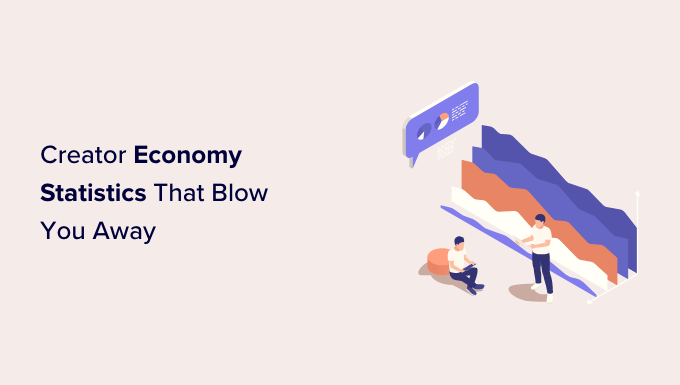[ad_1]
Want to explore the recent trends and statistics in the creator economy?
The industry is home to content creators worldwide and grows a lot every year. From full-time content creators to hobbyists, the creator economy is made up of different creator profiles with different skills.
The creator economy also favors brands around the globe. It offers collaboration opportunities and helps businesses use different platforms to engage with their target audiences.
In this article, we have gathered a ton of creator economy statistics that will help you know the industry inside out.

List of Creator Economy Statistics
To help you explore all the different insights in our research post, we have divided the creator economy statistics into different categories.
By clicking the links below, you can jump to the section that you are most interested in and view the different statistics:
General Creator Economy Statistics

The estimated worth of the creator economy is $104.2 billion.
The creator economy is expected to double in size by 2027.
The creator economy has 207 million content creators worldwide.
The industry has 200 million active content creators.
The creator economy has over 2 million expert content creators.
Shopify is a leading company supporting the creator economy, with an annual revenue of $5200 million.
The creator economy is growing at a really fast pace. It is expected to double in the next few years as the industry welcomes new content creators every day.
Leading companies contribute to the creator economy’s growth by either providing services to content creators or working with them to promote different solutions.
This makes it possible for both brands and content creators to benefit from partnerships.
If you are a content creator, then you can join affiliate programs within your niche and make money writing about and promoting these products. Alternatively, you can work directly with brands and get sponsorships.
Apart from social media platforms like YouTube and TikTok, it’s a good idea to create a WordPress website. This will give you full control over your content. Plus, having a website makes it easier for brands to find you and reach out to you for partnerships.
As a business, you can enter the creator economy by sponsoring influencers or starting your own affiliate marketing program with a plugin like AffiliateWP. That way, you can quickly get more referrals to your products and services.
Creator Profile Statistics

There are more than 45 million professional content creators in the creator economy.
51.9% of content creators in the industry are women, with men making up 48.1%.
The creator economy has more than 162 million amateur content creators.
46.7% of people identify as full-time content creators, followed by 42.7% as part-timers.
10.6% of people consider content creation a hobby.
Only 0.96% of content creators have more than 1 million followers.
The gender gap in the creator economy is not that high. However, the industry has more female content creators than men.
The majority of people in the industry work as full-time content creators. However, there are some who work 9–5 and create content to make a decent amount of money.
Influencer Statistics

The current estimated value of the influencer industry is $17.4 billion, which is expected to grow to $22.2 billion by 2025.
The expected growth rate of the influencer industry is 14.47%.
78% of influencers earn around $23,500 per year.
The average influencer income is $76 per hour.
83% of people believe influencer marketing is an effective marketing tactic.
63% of brands use artificial intelligence (AI) for their influencer marketing campaigns.
Brands spend $6 billion on influencer collaborations.
82% of the total influencer marketing budget is spent on influencer collaborations in the United States.
On average, lifestyle influencers pitch $994 for a collaboration, followed by fashion influencers at $912.
On average, brands spend $257 per collaboration with an influencer.
The average time influencers take to respond to collaboration requests is 14 hours.
Influencers usually take 16 days to wrap up a collaboration.
42% of influencers prefer to be paid for a collaboration.
26% of influencers produce user-generated content like reviews, unboxings, testimonials, etc.
50% of people prefer purchasing products from their favorite influencers.
Influencers are active on at least 2 social media platforms.
Professional content creators have a lot of influence in their niches. This makes them ideal candidates for brand collaborations.
For this reason, around 68% of companies prefer working with influencers. The creator economy acts as a bridge. It allows brands to onboard influential content creators and helps independent creators make a living from collaborations.
Influencers generally have a huge follower base. So, they can help your business increase its brand awareness and connect with online communities.
This partnership can help you attract more traffic to your website and capture high-quality leads.
Work Preference Statistics

85% of full-time content creators enjoy what they do.
1/3 of content creators prefer creating a single type of content.
58% of content creators generally produce 2–4 types of content.
94.5% of content creators use AI tools.
For more than 25% of full-time content creators, follower growth is a preferred metric to measure their success.
37% of full-time content creators prefer working solo.
45% of part-time content creators prefer hiring staff.
More than 35% of full-time content creators prefer creating content around entrepreneurship.
More than 20% of hobbyists prefer creating content around personal development.
Only 5% of content creators spend more than 40 hours each week creating content.
A majority of full-time content creators and hobbyists prefer to work alone. However, most of the part-time content creators do not mind hiring help.
Creators usually experiment with different types of content until they find what works for them. However, full-timers generally prefer creating content that talks about new business ideas.
Full-time content creators measure success by the rate at which their followers grow. Plus, they do not shy away from using AI tools to be more efficient at work.
For example, with AI-powered tools like All in One SEO (AIOSEO), you can easily optimize your written content for search engines.
AIOSEO comes with a powerful AI title and description generator that can help you write better headings and meta descriptions for your written content. This can help you improve your rankings in Google and get a bigger audience for your content.
Earnings Statistics

More than 45% of content creators use revenue as a metric to measure their success.
52% of content creators are monetized (make money from their content).
78% of monetized content creators are women.
59% of beginner content creators are still waiting for monetization.
Monetized content creators generally earn $51 per hour on average.
32% of content creators own businesses related to creative work.
The average income of content creators who run a business is $75 per hour.
67% of content creators sell products or merchandise to get more revenue.
28% of content creators make income through partnerships and promotions.
29% of content creators generate revenue through affiliate links.
35% of content creators make a living through ad revenue.
25% of content creators earn $50–100K a year.
Only 2% of content creators make more than $1 million a year.
To make more than $1 million a year, content creators need more than 5 million followers.
26% of content creators make the most money from TikTok and YouTube, respectively.
48% of people do not mind paying a subscription fee to access exclusive content.
29% of people want to support their favorite content creators because they inspire them.
35.3% of people give tips to their favorite content creators to support them.
50% of people have tipped their favorite content creators at least once.
More than 40% of people tip $5 to $10 on average to their favorite content creators.
Most content creators let their earnings define their success. So, they often choose to own a business even if they are already monetized on social platforms.
Monetized content creators make the most money from TikTok and YouTube. Female content creators have the advantage here.
Apart from business income and ad revenue, content creators also earn through affiliate links and paid promotions.
Furthermore, the majority of people are willing to pay a premium fee to get exclusive content from their favorite content creators. This means you can easily make more money by making restricted content.
You could make a membership website. That way, users will need to pay to get past your paywall and get access to your content.
For example, 40 Aprons is a health and wellness blog that uses MemberPress to offer its visitors access to premium content like diet plans and secret recipes.
Alternatively, if you have something to teach your followers, then Thrive Apprentice is a great option. It allows you to make and sell online courses to your audience.
Engagement Statistics

29.3% of content creators publish content frequently on social media to engage their audiences.
5.6% of content creators host meetups to increase engagement.
62% of content creators say that focusing on a particular niche helps them get more engagement and reach.
More than 25% of content creators say that Instagram is the top channel for generating engagement.
Engagement is one of the main metrics that content creators use to measure their performance.
To meet engagement goals, content creators often focus on a specific niche and create content around relevant topics.
Publishing content on a regular basis is the key here. However, some content creators go the extra mile and host virtual events or in-person meetups to engage with their audiences.
Running competitions and giveaways on your website is also an excellent way to boost engagement.
With RafflePress, you can easily run giveaways on your WordPress website without having to hire a developer. This can help you get more followers and shares on social media, as well as subscribers to your email list.
Challenges Statistics

14.6% of content creators say their greatest challenge is finding brand deals.
63% of full-time content creators have experienced burnout at least once in the last 12 months.
13% of full-time content creators consistently have extreme levels of stress, followed by part-timers at 9%.
More than 45% of full-time content creators say the pressure to post everywhere causes burnout, followed by content fatigue at around 44%.
It may seem like content creators are living the dream. However, they can have challenges from time to time.
Always meeting audience expectations can be overwhelming. It can severely affect the health and well-being of some content creators.
Whether they are full-time content creators or part-timers, creators often report extreme levels of stress trying to meet the demand for new content.
When you create content day in and day out, you may eventually run out of content ideas.
The WPBeginner Blog Post Idea Generator can come in handy here. The tool instantly generates 100s of content ideas to help you find new topics and inspiration.
YouTube Statistics

With 2.2 billion monthly active users, YouTube is one of the most popular social media platforms.
YouTube channels grow by 36% per year.
69% of influencers on YouTube are women, followed by men at 31%.
YouTube supports multiple languages, covering 95% of internet users.
197 million YouTube users are from the United States.
29% of children in the United States want to be YouTubers or vloggers one day.
Only 3% of YouTubers make 90% of the money generated through the platform.
An average content creator on YouTube has a 1/57 chance of crossing the 10,000 subscribers milestone.
10% of the content published by popular YouTube channels gets 79% of the total views.
70% of YouTubers prefer creating long-form content.
On average, brands spend $418 to collaborate with YouTubers.
25% of people prefer to watch live streams on YouTube.
25.9% of people prefer YouTube for tipping or subscribing to their favorite content creators.
YouTube is one of the leading social media platforms. Creators use the platform to engage their audiences with long-form content and make a living from ad revenue.
However, this is not the only way content creators earn money through YouTube. People also prefer the platform for live streams, where they support their favorite creators through tips.
So, if you are a content creator, live streaming on YouTube is a good option for you to grow your income.
You can also embed your live stream on your WordPress website. This is one of the most effective ways to attract more viewers and grow your audience.
Plus, you don’t need to hire a coding expert for this. You can simply use Smash Balloon YouTube Feed to embed your YouTube streams on your website.
Instagram Statistics

25% of people say that Instagram has the potential to generate the highest return on investment (ROI).
29% of brands plan to invest the most in Instagram because of the platform’s potential to help them grow their audiences.
Instagram is one of the most popular platforms, with 2 billion monthly active users.
79% of influencers on Instagram are women, followed by men at 21%.
9 out of 10 Instagram users consume video content on a weekly basis.
89% of Instagram users live outside the United States.
11% of Instagram users in the United States use the platform as their go-to news source.
Instagram is also an ideal place for content creators to score brand deals and sponsorships.
Instagram users are also generally very active. So, engaging them may be easier compared to other platforms.
Additionally, by embedding your Instagram feed on your website, you can show user-generated content to build trust and grow your brand’s reach.
Smash Balloon Instagram Feed can help you with that. Using this plugin, you can easily add customizable social media feeds to your website and show your content to more people.
TikTok Statistics

26% of content creators say that their preferred social media platform is TikTok.
TikTok has over 1 billion monthly active users.
53% of TikTok users are women, followed by men at 46%.
76% of influencers on TikTok are women, followed by men at 24%.
80 million monthly active users on TikTok are from the United States alone.
37.3 million active users on TikTok represent Gen Z.
TikTok users are active for around 95 minutes on a daily basis.
56% of brands prefer TikTok to collaborate with influencers.
The highest-earning content creator on TikTok is Charli D’Amelio.
TikTok is one of the fastest-growing social media platforms. Over 1 billion people use the app to get their daily dose of content, especially people from Generation Z.
This is why most content creators prefer TikTok to showcase their creativity to their fans. TikTok is also preferred by many brands for partnerships.
Facebook Statistics

With 2.9 billion monthly active users, Facebook is one of the most popular social media platforms.
26.4% of people who use Facebook are millennials.
Facebook is the source of news and updates for 43% of adults in the United States.
TikTok may be the preferred platform to engage Generation Z. But Facebook is the go-to place for content creators who want to connect with millennials.
Businesses often use Facebook to create an online community. It helps them humanize their brand and engage with their audience.
We even do the same at WPBeginner. We created our own Facebook group called WPBeginner Engage to help WordPress users improve their websites and connect with 95k+ like-minded people.
List of Sources
WPBeginner, MemberPress, RafflePress, Smash Balloon, Statista, Adobe, Forbes, HubSpot, Exploding Topics, Linktree, The Influencer Marketing Factory, Influencer Marketing Hub, ConvertKit, Collabstr, Zippia, Goldman Sachs, Demand Sage
We hope this list of creator economy statistics, trends, and facts will help you make a marketing strategy that works best for your business. You may also want to see our guide on how to start a successful YouTube channel for your business and our expert picks for the best marketing automation tools for small businesses.
If you liked this article, then please subscribe to our YouTube Channel for WordPress video tutorials. You can also find us on Twitter and Facebook.
[ad_2]
Source link
